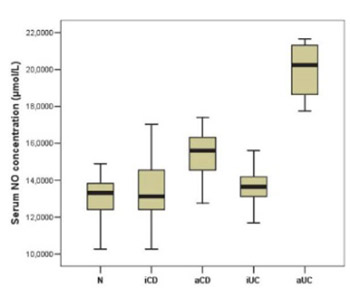Nitric oxide as a potential biomarker in inflammatory bowel disease
DOI:
https://doi.org/10.17305/bjbms.2013.2402Keywords:
nitric oxide, inflammatory bowel disease, ulcerative colitis, Crohn’s diseaseAbstract
The aim of this study was to investigate changes in serum nitric oxide (NO) concentration in inflammatory bowel diseases (IBD) patients and its use as potential biomarker in differential diagnosis of ulcerative colitis (UC) and Crohn's disease (CD) and in disease activity assessment. In 60 patients of both genders - 30 with ulcerative colitis and 30 with Crohn's disease - and 30 controls serum nitric oxide concentration was determined by measuring nitrite concentration, a stable metabolic product of NO with oxygen. Conversion of nitrates (NO3-) to nitrites (NO2-) was done with elementary zinc. The nitrite concentration was determined by classic colorimetrical Griess reaction. Median serum NO concentration was statistically different (p=0,0005) between UC patients (15.25 µmol/L; 13.47 - 19.88 µmol/L), CD patients (14.54 µmol/L; 13.03 -16.32 µmol/L) and healthy controls (13.29 µmol/L; 12.40 - 13.92 µmol/L). When active UC and CD patients were compared with inactive UC and CD patients respectively a significant difference in serum NO level was found (p=0.0005). With a cut-off level of 17.39 µmol/L NO had a sensitivity of 100% and a specificity of 100% in discriminating between active and inactive UC patients. With cut-off value of 14.01 µmol/L serum NO level had a sensitivity of 88% and a specificity of 69% in distinguishing between patients with active CD and inactive CD. Serum NO concentration is a minimally invasive and rapid tool for discriminating between active and inactive IBD patients and could be used as useful biomarker in monitoring of disease activity in IBD patients.
Citations
Downloads

Downloads
Published
How to Cite
Accepted 2017-09-03
Published 2013-02-20









